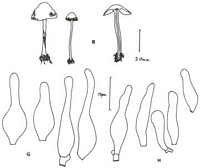|
 Conocybe novae-zelandiae Conocybe novae-zelandiae
BiostatusPresent in region - Indigenous. Endemic
Images (click to enlarge)
Caption: B, G-H Taylor 178 (holotype), B. Habit sketch and section; G. Cheilocystidia; H. Caulocystidia. |
Article: Watling, R.; Taylor, G.M. (1987). Observations on the Bolbitiaceae: 27. Preliminary account of the Bolbitiaceae of New Zealand. Bibliotheca Mycologica 117: 61 p. + 17 pl.
Description: Pileus 25 mm conical or campanulate, ochraceous yellow, darker and more tawny at disc, dry, dull. Stipe 50-55 mm, equal, but variable in thickness, flattened near apex, in one larger basidioma wider at gill-attachment, slightly twisted, Whining, pale above, darkening towards the base, fibrous, pubescent throughout, cottony towards base, easily separable from pileus, stuffed. Gills adnexed, brownish ochre, with white, serrate edge. Flesh pale yellowish, thin in pileus, concolorous in stipe.
Basidiospores bright orange-brown in mass, 9.5-10.5 x 5-6 µm, ellipsoid-amygdaliform, pale to medium ochraceous in water, darker in aqueous alkali solutions; germ-pore present, central. Basidia 4-spored, clavate, 21-29 x 7-9.5 µm. Cheilocystidia irregularly lageniform, 29-54 x 7-10.5 µm, head 3.5-6 µm, sometimes with secondary swelling half-way down neck or with side-branch. Caulocystidia in radiating clumps, lageniform, with less markedly elongate neck than in cheilocystidia, 24-48 x 8-12 µm. Pileipellis a palisadoderm of spheropedunculate cells intermixed with a few shortly lageniform pilocystidia, 23.5-36 x 6-9.5 µm, neck 4.5-6 µm broad. Clamp-connections present.
Notes: A very distinctive member of Conocybe sg. Piliferae related to the North American C. capillaripes (Peck) Singer, and the European C. aberrans (Kühner) Kühner, and closer to the latter. The former differs in its more slender stature and larger spores 12-15.5 x 7.5-10 (-10.5) µm (from type-material) and the latter particularly in its more ellipsoid amygdaliform basidiospores, more campanulate pileus and habitat preferences, viz. burnt patches. The basidiospores of C. aberrans are similar, viz. 8.5-10(-12) x 5-5.7(-6.5) µm.
|